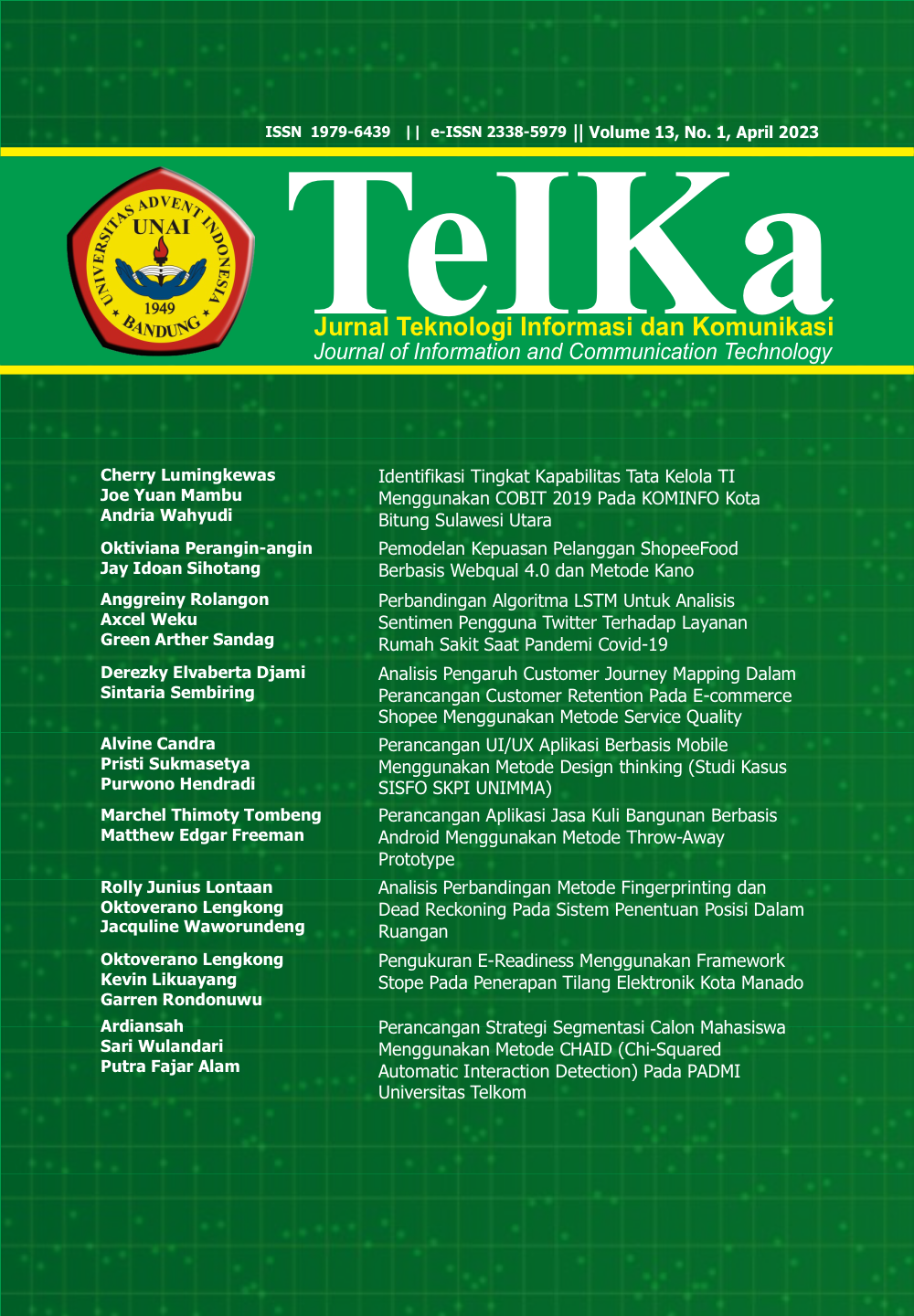Shopeefood Customer Satisfaction Modeling Based on Webqual 4.0 and Kano Method
Keywords:
ShopeeFood, Kano Model, Customer Satisfaction, WebqualAbstract
The development of technology today allows many people to be able to maximize the use of the internet in meeting their daily needs. One of the applications used is Shopee with the Shopee Food service which offers many promos and various food options. The purpose of this research was to see the effect of the attributes in Webqual 4.0 on the projection of the Kano Model regarding customer satisfaction with ShopeeFood services. In this case, the researcher will conduct research on Indonesian Adventist University students as respondents to the research. The division of the questionnaire is divided into two main parts, namely the webqual method questionnaire which assesses the reality and expectations of the service, and the Kano model which assesses the functionality, dysfunctionality and importance of each feature or attribute. The results of the research show that the respondents were satisfied with the ShopeeFood service with a score of the Usability aspect with a score of 4.15, Information Quality with a value of 4.02, and Service Interaction Quality with a value of 4.00. The results of webqual data processing are supported by the results of the kano model questionnaire data processing. Where satisfaction with the ShopeeFood service is reflected in the presence of several features/attributes that meet the expectations of users. Overall, each feature/attribute is included in the Attractive category (A).
Downloads
References
P. A. K. Wardani, F. R. Reinaldy, dan I. P. Tyas, “Analisis Faktor-Faktor Keputusan Pembelian Makanan Dengan Menggunakan Jasa ShopeeFood,” Literasi : Jurnal Kajian Keislaman Multi-Perspektif, vol. 2, no. 1, hlm. 163–192, Des 2021, doi: 10.22515/literasi.v2i1.4410.
A. Sutoni dan P. Ramadian, “Analisis Kepuasan Konsumen dan Pengembangan Produk Menggunakan Metode Kano dan House Of Quality,” hlm. 10, 2019.
S. A. Lahallo dan E. B. Wagiu, “Analysis of OVO Merchant Satisfaction Levels at 5 Shopping Centers in Bandung City Based on the Kano Model,” JST, vol. 11, no. 1, hlm. 14, Des 2020, doi: 10.30700/jst.v11i1.1059.
B. S. Silalahi dan F. J. Kaunang, “Analisis Service Quality pada Aplikasi DANA berdasarkan Sudut Pandang Pelanggan di Daerah Bandung Menggunakan Metode Servqual dan Model Kano,” TeIKa, vol. 12, no. 02, Art. no. 02, Okt 2022, doi: 10.36342/teika.v12i02.2957.
I. Rahmayuni, H. Humaira, dan D. Defni, “Pemanfaatan Metode Kano untuk Menilai Tingkat Kepuasan Pengguna terhadap Fungsionalitas Sistem Informasi Kepegawaian (Studi Kasus : AKNP Pelalawan),” Jurnal Inovtek Polbeng Seri Informatika, vol. 1, no. 2, hlm. 133–139, 2016, doi: 10.35314/isi.v1i2.132.
E. Sauerwein, F. Bailom, K. Matzler, dan H. Hinterhuber, “The Kano Model: How to Delight Your Customers,” International Working Seminar on Production Economics, vol. 1, Jan 1996.
“Analisis Kualitas Layanan Website E-Commerce Berrybenka Terhadap Kepuasan Pengunjung Menggunakan Metode WebQual 4.0 dan Importance Performance Analysis (IPA) | Jurnal Pengembangan Teknologi Informasi dan Ilmu Komputer.” https://j-ptiik.ub.ac.id/index.php/j-ptiik/article/view/753 (diakses 12 November 2022).
R. A. Setyawan dan W. F. Atapukan, “PENGUKURAN USABILITY WEBSITE E-COMMERCE SAMBAL NYOSS MENGGUNAKAN METODE SKALA LIKERT,” Compiler, vol. 7, no. 1, Art. no. 1, Mei 2018, doi: 10.28989/compiler.v7i1.254.
I. M. I. Subroto dan S. F. C. Haviana, “Sistem Informasi Angket Pengukuran Skala Kebutuhan Materi Pembelajaran Tambahan Sebagai Pendukung Pengambilan Keputusan Di Sekolah Menengah Atas Menggunakan Skala Likert,” vol. 1, no. 2, hlm. 12, 2016.
N. M. Janna dan H. Herianto, “Konsep Uji Validitas Dan Reliabilitas Dengan Menggunakan SPSS.” OSF Preprints, 22 Januari 2021. doi: 10.31219/osf.io/v9j52.
R. R. F. Tambunan, J. I. Sihotang, dan J. Y. Mambu, “Analisa Tingkat Kepuasan Kerja Driver Maxim Terhadap Sistem Layanan Maxim Dengan Pieces Framework,” CogITo Smart Journal, vol. 7, no. 2, hlm. 339–348, Des 2021, doi: 10.31154/cogito.v7i2.330.339-348.
M. Z. Yang dan J. I. Sihotang, “Analisis Kepuasan Pengguna Terhadap User Interface Aplikasi E-Commerce Shopee Menggunakan Metode EUCS di Jakarta Barat,” Informatics and Digital Expert (INDEX), vol. 4, no. 2, Art. no. 2, 2022, doi: 10.36423/index.v4i2.1110.
M. Syifaurahman, E. T. Gumelar, dan Muhardi, “Perancangan Sistem Informasi Pelayanan Travel Haji dan Umrah Menggunakan WebQual dan Model Kano di Perusahaan Jasa,” Bandung Conference Series: Business and Management, vol. 2, no. 1, Art. no. 1, Jan 2022, doi: 10.29313/bcsbm.v2i1.1678.
Downloads
Published
How to Cite
Issue
Section
License
Copyright (c) 2023 TeIKa

This work is licensed under a Creative Commons Attribution-ShareAlike 4.0 International License.
The submitting author warrants that the submission is original and that she/he is the author of the submission together with the named co-authors; to the extend the submission incorporates text passages, figures, data or other material from the work of others, the submitting author has obtained any necessary permission.
Articles in this journal are published under the Creative Commons Share Alike Attribution Licence (CC-BY-SA What does this mean?). This is to get more legal certainty about what readers can do with published articles, and thus a wider dissemination and archiving, which in turn makes publishing with this journal more valuable for you, the authors.
By submitting an article the author grants to this journal the non-exclusive right to publish it. The author retains the copyright and the publishing rights for his article without any restrictions.










